THE MONUMENTS OF MARRAKECH
Marrakech, known as the « Pearl of the South », is a Moroccan city renowned for its remarkable architecture and iconic monuments. Marrakech Events, a specialized agency in organizing events, seminars, and incentive trips in Marrakech, will introduce you to these monuments throught a tailor-made program designed for both companies and private groups.
Here is a detailed description of some of Marrakech’s most significant monuments:
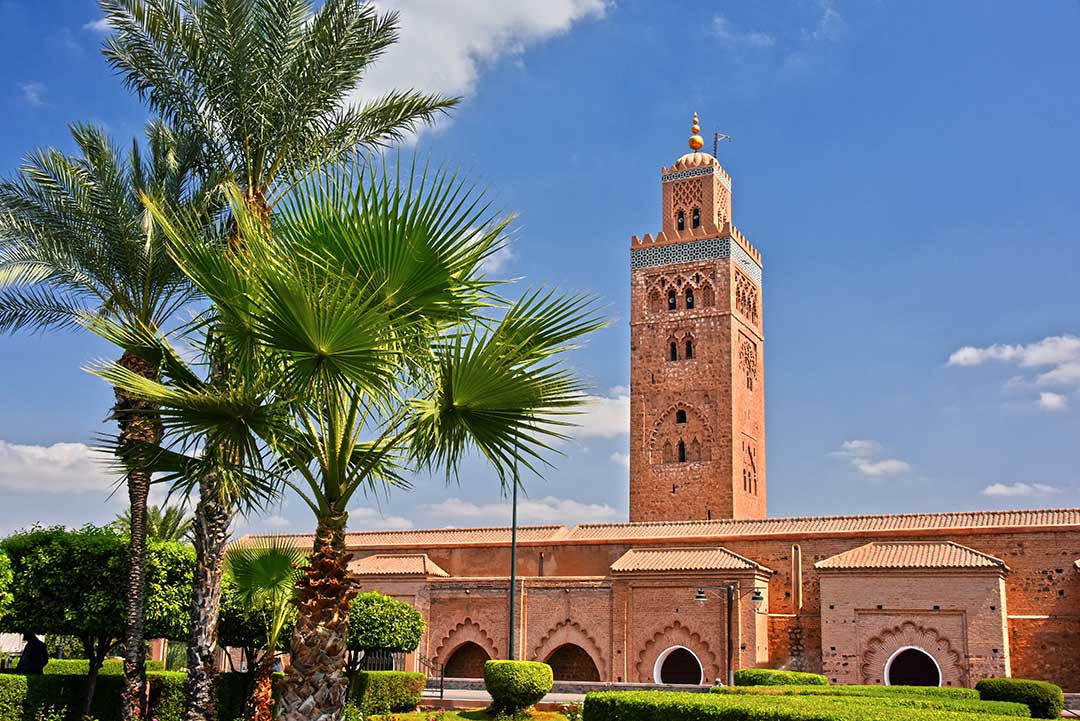
THE KOUTOUBIA MOSQUE
This mosque is one of the most famous symbols of Marrakech. The Koutoubia Mosque is one of the most iconic monuments in Marrakech. Built in the 12th century during the reign of the Almohads, this mosquer serves as a place of worship for Muslim believers.
The Koutoubia Mosque is particularly renowned for its impressive minaret, soaring to a height of 77 meters. This minaret, featuring typical Almohad architecture, consists of three distinct sections adorned with intricately carved geometric patterns and arabesques. It is crowned with gilded lanterns.
The Koutoubia Mosque boasts a vast prayer hall that can accommodate up to 20,000 worshippers. Its interior architecture is understated yet elegant, featuring marble columns, horseshoe arches, and intricately carved wooden vaults.
The entire mosque complex is surrounded by a beautiful garden featuring paved pathways, fountains, and flower beds, providing a tranquil space for relaxation and contemplation. Palm trees and orange trees add a touch of greenery to the surroundings.
While access to the Koutoubia Mosque is reserved for Muslims during prayer times, visitors can still admire its architectural beauty from the outside. Many tourists also visit the adjacent gardens to enjoy the tranquility of this iconic space in Marrakech.
In summary, the Koutoubia Mosque is an architectural gem, renowned for its impressive minaret and peaceful gardens. It is a must-visit when exploring Marrakech and an important symbol of Moroccan history and culture.
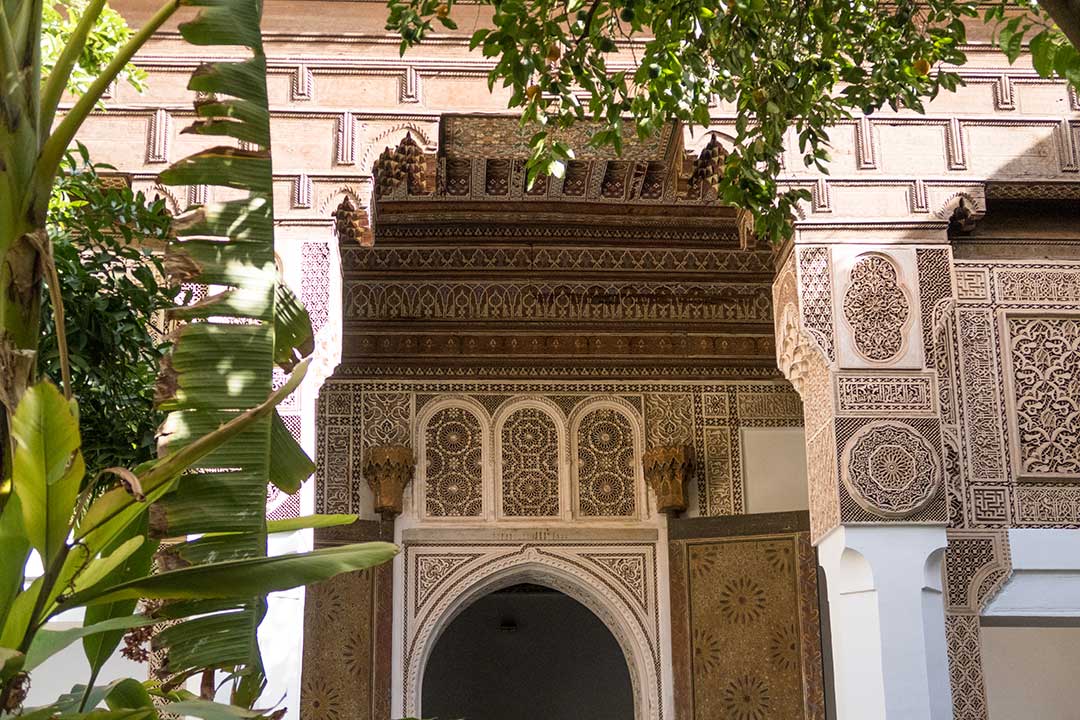
THE BAHIA PALACE
Built in the 19th century, this magnificent palace is renowned for its lush gardens and lavishly decorated interiors. The colorful mosaics, intricately carved wooden ceilings, and flower-filled courtyards make the Bahia Palace one of the most impressive monuments in Marrakech. Constructed in the 19th century, this splendid palace is celebrated for its refined architecture, opulent gardens, and exquisitely adorned interiors.
The Bahia Palace, whose name translates to “brilliance” or “beauty,” was commissioned by the Grand Vizier Si Moussa and later completed by his successor, Ba Ahmed. It is considered one of the finest examples of Moroccan architecture from that era.
The exterior of the palace features walls made of pisé adorned with delicately sculpted geometric motifs and Arabic calligraphy. Upon entering, one discovers a vast complex consisting of multiple courtyards, patios, gardens, and private apartments.
The gardens of the Bahia Palace are a true haven of peace, providing a green oasis in the heart of the city. You’ll find numerous fruit trees, colorful flowers, refreshing fountains, and shaded pathways. The gardens are also adorned with pavilions, lookout points, and terraces offering breathtaking views of the surroundings.
The interiors of the palace reflect extraordinary luxury and refinement. The rooms are adorned with precious materials such as marble, cedar wood, and finely sculpted stucco. The ceilings are embellished with intricate patterns, and the walls are adorned with colorful mosaics and traditional zellige tilework.
The numerous lounges and chambers of the palace were intended to host royal guests and high dignitaries. Today, some parts of the palace are used for exhibitions and cultural events, allowing visitors to immerse themselves in Moroccan history and culture.
The Bahia Palace in Marrakech is an ideal venue for hosting various types of special events. Here are some examples of events frequently organized at the Bahia Palace:
1. Weddings: The Bahia Palace offers an enchanting setting for celebrating a wedding. The beautiful gardens, lavish interiors, and Moorish architecture make it a prime location for a romantic and memorable wedding ceremony.
2. Gala Dinners: The spacious halls of the Bahia Palace can accommodate grand gala dinners. Guests can enjoy an elegant evening in a royal setting, surrounded by architectural splendor and a historic atmosphere. Contact Marrakech Events for organizing a gala dinner at the Bahia Palace!
3. Business Meetings and Conferences: The various meeting rooms at the Bahia Palace are perfect for hosting business meetings, conferences, or seminars. The architecture and ambiance of the venue add a touch of prestige to these professional events.
4. Artistic and Cultural Exhibitions: Some spaces in the Bahia Palace can be used for art exhibitions, cultural presentations, or specific events highlighting Morocco’s artistic and traditional heritage.
5. Shows and Concerts: The expansive interior courtyards of the Bahia Palace can be transformed into stages to host shows, concerts, or artistic performances. The gardens and terraces can also be utilized for outdoor performances.
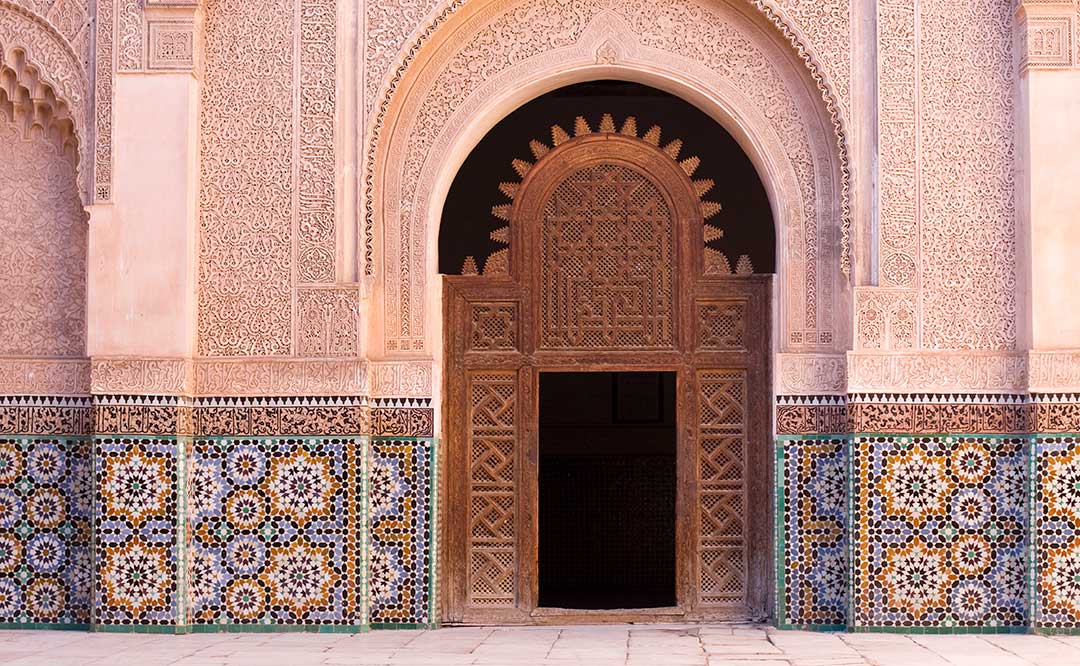
THE BEN YOUSSEF MEDERSA
This ancient Quranic school, built in the 14th century, is a masterpiece of Islamic architecture. It is adorned with magnificent mosaics, intricately carved plasterwork, and complex geometric patterns. The inner courtyard is a place of serenity with its marble columns and central basin.
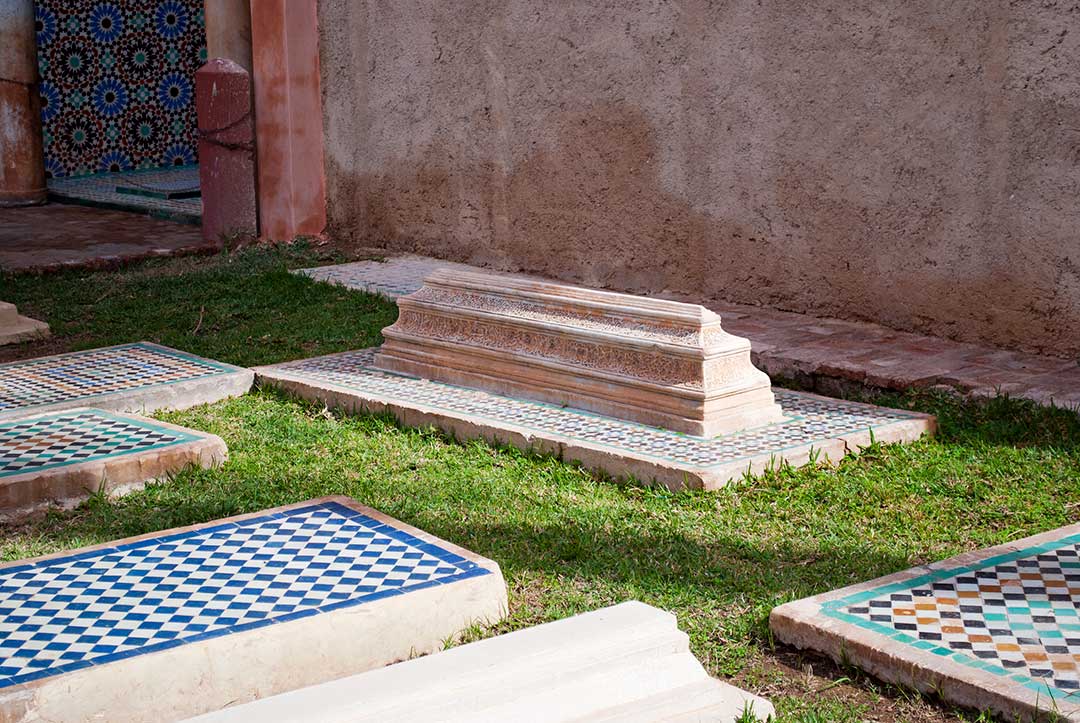
THE SAADIAN TOMBS
The Saadian Tombs are a historic monument in Marrakech, Morocco. These tombs date back to the time of the Saadian dynasty, which ruled Morocco from the 16th to the 17th century.
The Saadian Tombs were rediscovered in 1917 and are considered a true architectural treasure. They are located in a small necropolis, hidden behind high walls, near the Kasbah Mosque.
The Saadian Tombs house the burial sites of members of the Saadian dynasty, including that of Sultan Ahmed al-Mansur. The tombs are organized around three main mausoleums: the main mausoleum (Mausoleum of Ahmed al-Mansur) and the two adjacent mausoleums (Mausoleum of his son and Mausoleum of his mother).
The structures of the main mausoleum are adorned with a rich decoration of finely carved stucco, colorful mosaics, and detailed floral motifs, typical of Moroccan Islamic art. The tombs themselves are made of marble, each one surrounded by intricately carved wooden grilles.
In addition to the mausoleums, there is also a peaceful inner garden where visitors can stroll and admire the architecture and decorative elements of the tombs.
The discovery of the Saadian Tombs in 1917 allowed for their preservation after centuries of obscurity and opened them to the public as a historic monument. Today, the Saadian Tombs bear witness to the splendor of the Saadian dynasty and stand as an important tourist attraction in Marrakech.
A visit to the Saadian Tombs offers a fascinating dive into the history of Morocco, allowing visitors to admire Islamic architecture, exquisite artistic details, and gain a deeper understanding of the significance of the Saadian dynasty in Moroccan history and culture.
These tombs dating back to the 16th century were discovered in 1917 and provide a fascinating glimpse into the history of Marrakech. The tombs are adorned with magnificent stucco sculptures, colorful mosaics, and intricate floral motifs.
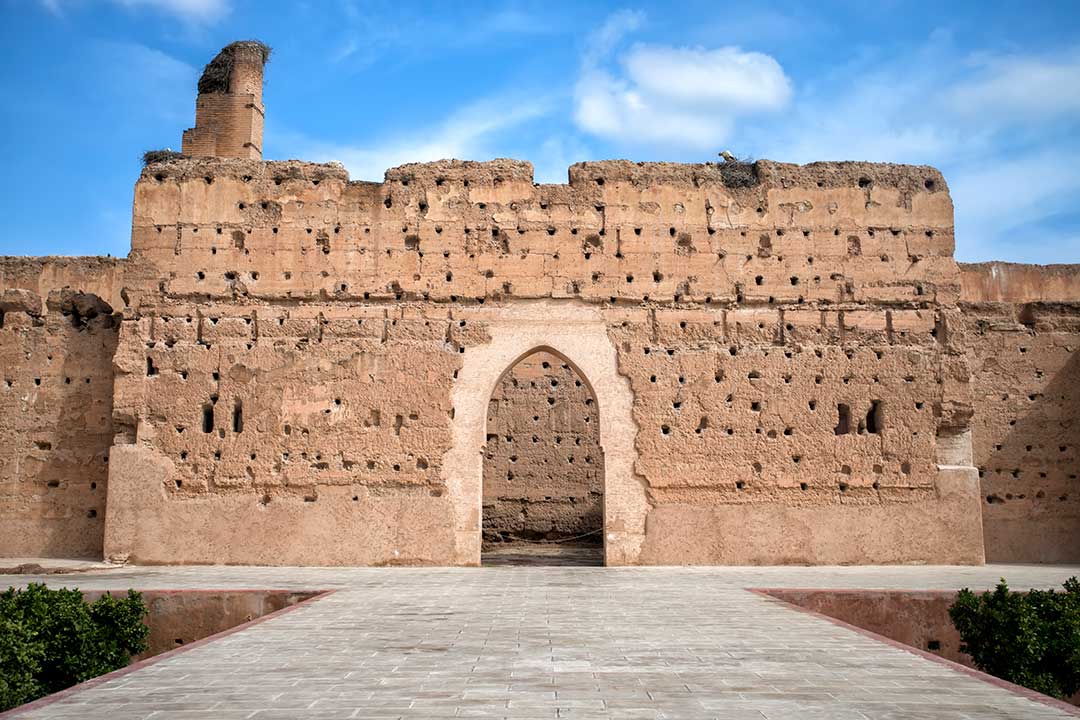
THE BADI PALACE
The Badi Palace is an ancient palace located in Marrakech, Morocco. It was built in the 16th century by the Saadian Sultan Ahmed al-Mansur Dhahbi, also known as Sultan El Badi.
The Badi Palace was once considered one of the most sumptuous and luxurious palaces in Morocco. With its extensive gardens, inner courtyards, pavilions, and numerous rooms, the palace was used to host official events, grand receptions, and extravagant celebrations.
However, after the death of Sultan El Badi in 1603, the palace began to decline. A significant portion of its precious materials, including gold, silver, and marble, were plundered to build other palaces and structures in the region.
Today, the Badi Palace is a major tourist site in Marrakech. While most of its structures have been destroyed, some elements are still visible, such as the immense pisé walls, expansive terraces, and water basins.
Visiting the Badi Palace allows visitors to imagine the former splendor of this place as they stroll through its impressive ruins and admire the remnants of its past grandeur. Additionally, the palace also houses a small museum that displays historical objects and artifacts from the Saadian era.
The breathtaking view from the terraces of the Badi Palace also provides a unique opportunity to gaze upon the Medina of Marrakech and the distant Atlas Mountains. Visiting the Badi Palace is, therefore, a chance to delve into Moroccan history and architecture while enjoying a panoramic view of the city. It’s a must-visit site in Marrakech for history and travel enthusiasts.
THE PRIVATE MUSEUM OF MARRAKECH
This museum was established by the Omar Benjelloun Foundation in 1997 with the aim of promoting Moroccan art and culture.
The Private Museum of Marrakech is located in a former riad, a traditional Moroccan house, which has been restored and adapted to house artworks and exhibitions. The riad itself is a magnificent example of Moroccan architecture and craftsmanship, featuring inner courtyards, arcades, and mosaics.
The museum showcases a collection of contemporary art, including paintings, sculptures, photographs, and installations by Moroccan and international artists. The exhibitions are regularly refreshed, providing visitors with the opportunity to explore new artistic creations.
In addition to its permanent and temporary exhibitions, the Private Museum of Marrakech also offers a library, a bookstore, and a café-restaurant where visitors can relax and dine.
The Private Museum of Marrakech is a popular destination for art enthusiasts and culture lovers. It provides an immersion into Moroccan contemporary art, offering a unique insight into artistic expression in Morocco.
Visiting this museum is an enriching experience for art enthusiasts as well as for anyone looking to explore the cultural and artistic scene of Marrakech. The Private Museum of Marrakech contributes to promoting Moroccan art and fostering cultural exchanges while providing a beautiful setting to discover and appreciate the exhibited artworks.
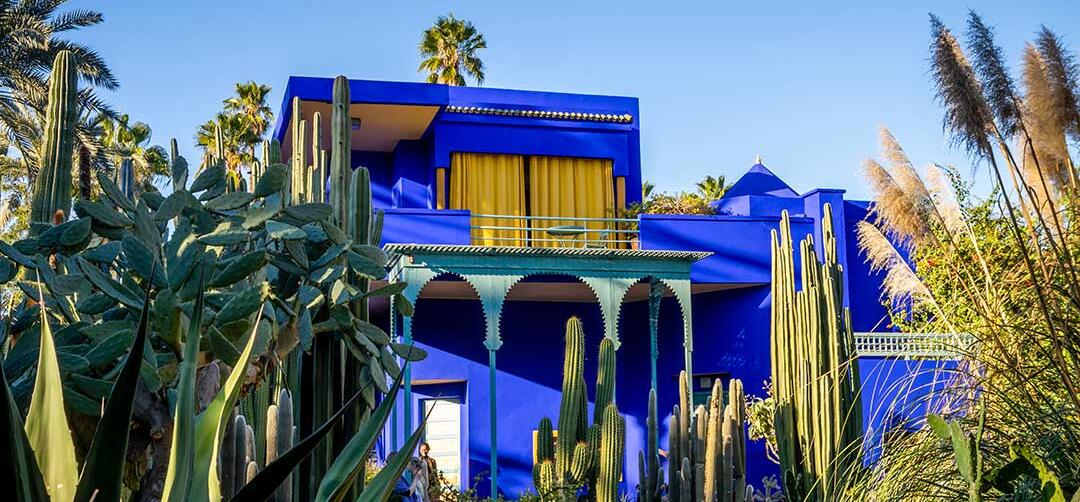
THE MAJORELLE GARDENS
The Majorelle Gardens are botanical and artistic gardens located in the heart of Marrakech. They were created by the French painter Jacques Majorelle in the 1920s and later acquired by the renowned fashion designer Yves Saint Laurent and his partner Pierre Bergé.
The Majorelle Gardens are designed as a peaceful oasis in the midst of the city’s hustle and bustle. They cover an area of two hectares and are filled with exotic and rare plants, including palm trees, cacti, bamboo, and tropical flowers. Paved pathways wind through the gardens, allowing visitors to stroll and discover various tranquil corners.
The most recognizable feature of the Majorelle Gardens is undoubtedly their vibrant color palette, featuring an intense blue known as “Majorelle blue” used in many architectural elements. This vivid blue beautifully contrasts with the yellow geometric patterns, colorful mosaics, and exotic wood structures found throughout the gardens.
In addition to the natural beauty of the Majorelle Gardens, the location also houses the Berber Museum. This museum displays a collection of jewelry, textiles, handicrafts, and Berber artifacts, providing an insight into the culture and history of this indigenous community in Morocco.
Since Yves Saint Laurent and Pierre Bergé acquired the Majorelle Gardens, they have dedicated efforts to restore and preserve them. Today, the gardens are one of the most visited attractions in Marrakech, attracting thousands of tourists every year.
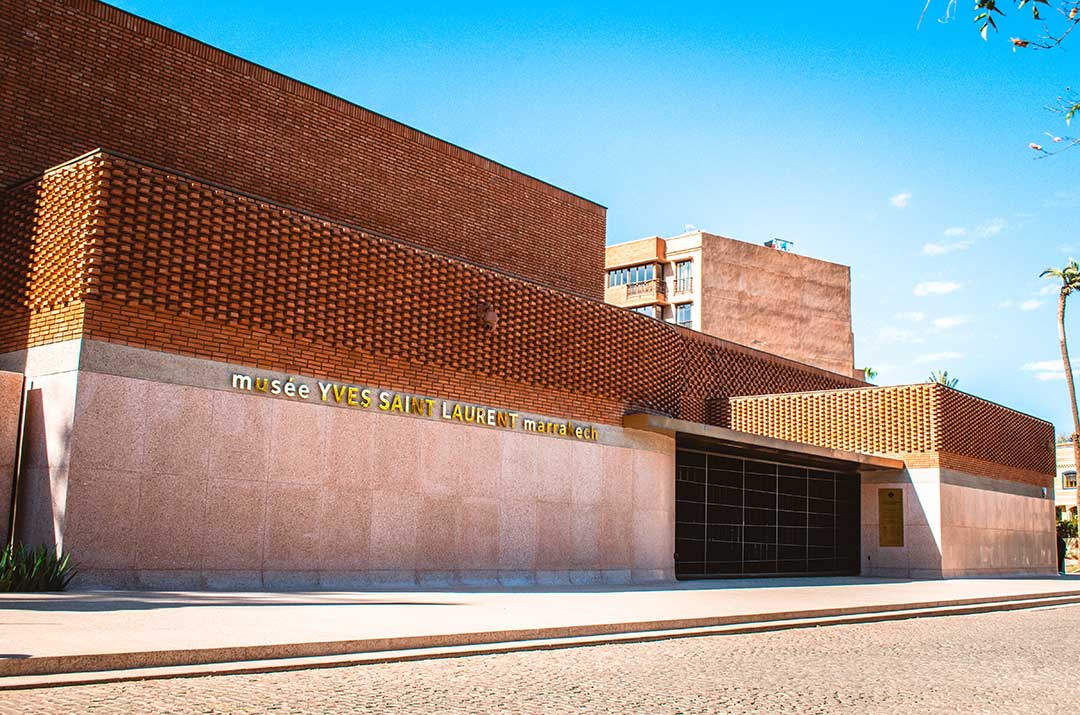
THE YVES SAINT LAURENT MUSEUM
Visiting the gardens now goes hand in hand with visiting the Yves Saint Laurent Museum, inaugurated in 2018.
The building itself is worth the visit. Its modern architecture, however, incorporates the color codes of Marrakech and those of traditional architecture.
Inside, you can discover beautiful pieces from the fashion designer’s collections. Ball gowns and cocktail dresses will dazzle you in an elegantly curated scenography.
A combined ticket allows you to seamlessly enjoy both visits.
THE DAR SI SAID MUSEUM
Located in an old palace known as Dar Si Said, which was built in the late 19th century by Si Said ben Moussa, a vizier of Sultan Hassan I, the Dar Si Said Palace itself is an example of traditional Moroccan architecture, with its magnificent courtyards, fountains, inner courtyards, and intricately carved woodwork. The museum is dedicated to Moroccan craftsmanship and showcases a diverse collection of art and craft objects, reflecting the richness and diversity of the country’s artisanal traditions.
A visit to the Dar Si Said Museum allows visitors to discover examples of Moroccan rugs, weavings, jewelry, pottery, ceramics, calligraphy, textiles, and woodwork. The exhibited pieces come from different regions of Morocco and showcase the artisanal craftsmanship passed down through generations.
In addition to its permanent exhibition, the museum also offers temporary exhibitions showcasing other forms of traditional Moroccan art and craftsmanship.
The goal of the Dar Si Said Museum is to preserve, promote, and celebrate Moroccan craftsmanship, highlighting the talent and creativity of local artisans. It is a must-visit place for enthusiasts of craftsmanship, art, and Moroccan culture, providing a unique insight into the country’s artisanal heritage.
A visit to the Dar Si Said Museum is a true immersion in Moroccan art and craftsmanship, allowing visitors to appreciate the beauty and intricacy of artisanal creations. It’s also an opportunity to support local artisans by becoming familiar with their work and understanding the traditional techniques used to produce these unique pieces.